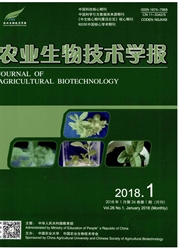

 中文摘要:
中文摘要:
以线粒体功能性蛋白替代氧化酶(alternative oxidase,AOX)为研究对象,对隐孢子虫(Cryptosporidium)分离株进行扩增和测序,并对测得的序列进行种系发育关系研究,以确定不同隐孢子虫分离株之间的进化关系,并以18SrRNA和HSP70基因构建的进化树作参照,评价AOX基因是否适合作隐孢子虫基因分型和进化关系分析的基因座。结果表明,在AOX序列构建的进化树上Cryptosporidum分为两大类:Cryptosporidium baileyi和C.meleagridis处于一个进化枝上,C.hominis、C.suis、C.parvum牛基因型和C.parvum鼠基因型处于另一个进化枝上。在C.parvum内,鼠基因型分离株和猪基因Ⅰ型(即C.suis)分离株与牛基因型和人基因型(即C.hominis)在AOX基因序列上都存在着差异。鹌鹑源C.meleagridis分离株与禽源C.baileyi3个分离株在AOX基因序列的同源性显著高于前者与C.parvum的同源性,在进化树上C.meleagridis与C.baileyi的亲缘关系也较其与C.parvum密切。AOX基因不仅可作为隐孢子虫分离株种系发育的遗传标记,又为发现隐孢子虫新的遗传特性提供了一种途径。
 英文摘要:
英文摘要:
The mitochondrial functional protein alternative oxidase (AOX) gene was used as the marker for analysing phylogentic relationship of the Cryptosporidium isolates. The AOX genes were characterized, and the phylogentic tree was established from the Cryptosporidium isolates, and compared with that of 18S rRNA and HSP70 gene sequences, then determined whether the AOX gene was suitable for phylogentic analysis of the genus of Cryptosporidium or not. The results revealed that the genus Cryptosporidium contained the phylogenetical distinct species C.parvum, C.hominis, C.suis and C.baileyi, which were consistent with the biological characteristics and host specificity up to date. The Cryptosporidium species formed two clades, one included C.hominis, C.suis, C. parvum cattle genotype and C.parvum mouse genotype and the other included C.meleagridis and C.baileyi isolates. Within C.parvum, both the mouse genotype isolate and the pig genotype Ⅰ (already known as C.suis) isolate differed from cattle genotype and human genotype (already known as C.hominis) based on the nucleotide sequences alignment. The identity of the AOX gene sequences between C.meleagridis and C.baileyi was more distinguishedly than that of between C.meleagridis and C.parvum, and the phylogentic trees showed that C.meleagridis had a closer phylogenetic affinity with the C.baileyi than that with C.parvum, this result was inconsistent with the phylogentic analysis results from 18S rRNA and HSP70 gene sequences, respectively. Present result suggested that the AOX gene is not only equally suitable for the phylogentic analysis of Cryptosporidium, but also provides an approach to identify new genes heredity of Cryptosporidium.
 同期刊论文项目
同期刊论文项目
 同项目期刊论文
同项目期刊论文
 期刊信息
期刊信息
